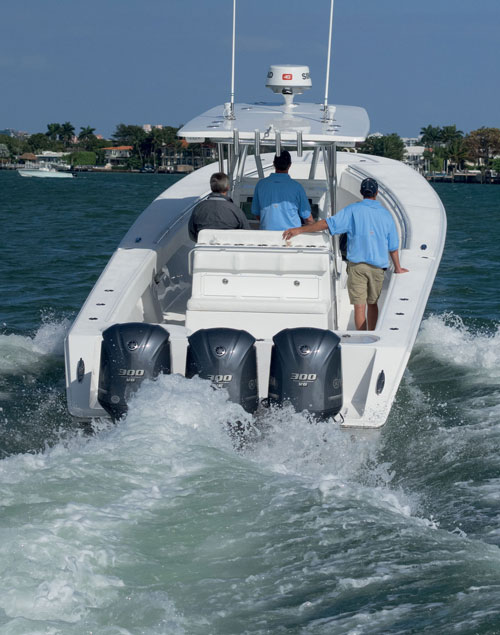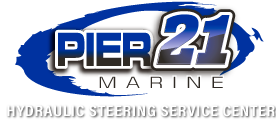
When people think of boat maintenance their attention usually turns to the engine and getting it serviced once a year. But what about other essential systems like hydraulic steering? Is there actually anything that can be done by the boat owner to make sure it works smoothly and, if so, how often should it be checked?
At Pier 21 Marine, we like to encourage preventative maintenance at least once a year, and to take the time to give your steering system a quick check every time you go out on the water. A few minutes looking things over will help you catch little problems before they become big ones. So where to start?
FIRST OF ALL, YOU NEED TO KNOW THAT A BASIC HYDRAULIC STEERING SYSTEM CONSISTS OF HELM, CYLINDER AND HOSE PLUS HYDRAULIC STEERING FLUID. ADDITIONAL COMPONENTS CAN ALSO BE PRESENT SUCH AS AN EXTRA HELM, AN EXTRA CYLINDER, AN AUTOPILOT OR A POWER ASSIST PUMP.
No matter how complicated the system, basic maintenance is much the same across most boats as follows:
- Level Check – Start by making a visual check at the helm(s) for any visible oil around seals and hose connections. Check the fluid level in the highest helm pump. In a front mount helm this should be 1/8”-1/4” below the bottom of the hole. Rear and tilt mount helms need to be 1” from top of the remote fill. If the level is a little low, you can simply top it off with hydraulic fluid but bear in mind that it may indicate there is a leak somewhere, so it is worth checking out the rest of the system before you top it off.
- Turn Test – After you’ve checked the levels and replaced the cap in the helm pump, turn the wheel smartly from side to side. You’re looking for an immediate response from the engine or drive unit. If there’s a noticeable lag in engine movement or a spongy feel when you turn the wheel, you’ve got a problem somewhere in the system that needs to be corrected. Be sure you run this check on all the steering wheels on your boat, including the autopilot, if you’ve got one.
- Hose Check – Next, take a minute to look at all the hoses and fittings. You’re looking for wear, kinks and/or leaks. A hose might be rubbing against a bulkhead and creating a weak spot. Maybe a fitting has worked loose and there’s a little leak starting. Catching these problems early makes for easy fixes.
- Ram Inspection – Lastly, inspect the steering tube and support rod, take a look at the exposed ram shaft and make sure everything moves smoothly as the engine pivots from side to side. Take a close look at the seals and wipers, and check for any bends, nicks or damage to the steering ram shaft.
If you notice a leak, a kink, a catch or any other potential issue, figure out what’s causing the problem and get it fixed before heading out for the day.
So that’s a quick check before each trip, but what about annual maintenance? At SeaStar we actually recommend you perform a complete system check every 6 months for boats operating in a harsh saltwater environment and once a year for freshwater. You’ll need a wrench or two plus a torque wrench to make certain you tighten all fittings to spec. You’ll also need a good quality marine grease like Sierra Premium Marine Bearing Grease and an ample supply of rags or paper towels.
- Back at the engine remove the support rod from the steering/tilt tube. Clean out the steering/tilt tube, and we mean really clean it out. Old grease can harden and needs to be removed, not to mention the fact that old dirty grease will contaminate the new grease.
- Grease the support rod liberally and re-insert back into the tilt tube. Also grease the tilt tube itself, as well as the support bracket holes. Put a little grease on the threads before you insert the washers and tighten up the nuts. (DO NOT remove the tiller bolt to re-grease the cylinder.)
- If you have an inboard system, make sure you grease the ball joint on the rudder(s).
- Check the tightness of ALL fasteners and fittings throughout the steering system. This means getting under or behind the dash to check the back of the steering helm pump too. A chart in your manual will give you all the relevant torque settings.
- Remove the steering wheel. If you have a tilt helm, remove the bezel, make sure the mechanism is clean and check the tightness of all fasteners. Tighten if necessary. Do not be tempted to disassemble the tilt unit other than removing the bezel. It contains springs under tension which could cause injury. Re-fit the bezel, grease the wheel shaft and re-attach the wheel using a new lock nut.
- Lastly, inspect the hydraulic oil for cleanliness. If it looks dirty, flush the system with clean oil. (This may be a task best handled by your dealer, as they’ve probably got an automatic pump like SeaStar’s Power Purge Jr that will refill and re-bleed your system more quickly and efficiently than doing it manually.)
A little attention to your steering system before every trip, and regular annual maintenance will assure you of proper operation and long-lasting performance of your SeaStar Hydraulic Steering System.

